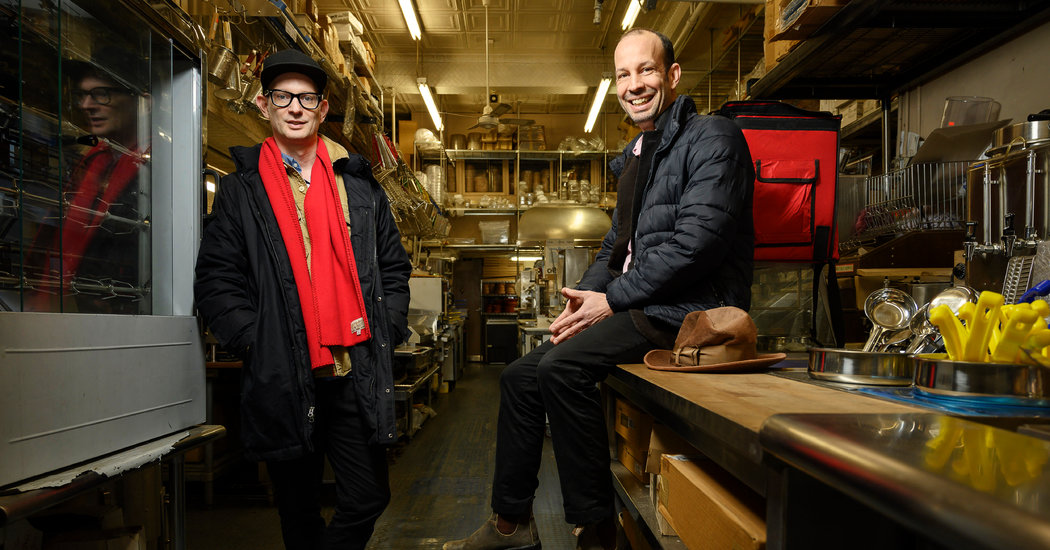
HOTBOX
Inside Catering, the Food World’s Riskiest Business
By Matt Lee and Ted Lee
James Beard, Martha Stewart, Ina Garten, Giada De Laurentiis, Carla Hall: Where were they before they became masters of the food universe? They were catering. If this is news to you, it’s not your fault. While restaurants and the life and times of the chefs who headline them have become a fixed, glamorized point of cultural interest, catering, as the chef Gabrielle Hamilton wrote in her memoir “Blood, Bones & Butter,” has been stigmatized as “the most unsavory corner of the food industry, except for maybe poultry processing.” Yes, before opening her restaurant, Prune, and becoming a best-selling author, she too worked in catering.
Hamilton is one of few people to write about this; it’s a subject food media like to pretend doesn’t exist. A few years later, a self-proclaimed “punk-rock caterer” known simply as Rossi published “The Raging Skillet,” which shares its title with her Lower East Side-based operation. Up until now, these memoirs might very well have been the only options for anyone curious about how those pigs-in-a-blanket wind up on cocktail trays or where those plates of beef tenderloin, a staple of weddings and charity galas, actually get cooked.
But after clocking what seem like countless — and sometimes, endless — shifts behind the “pipe and drape” (trade jargon for the black curtain separating the army of unseen staff from the action and the guests enjoying it) of the highest end of New York City’s catering scene, Matt and Ted Lee, the fraternal food writers and cookbook authors from Charleston, S.C., have chronicled their experiences slicing ham in prep kitchens, riding on transport vans, placing tiny tufts of microgreens on top of lamb shanks at plating stations and frying beignets to order for overfed guests.
In “Hotbox,” their report from the world of big-ticket catering, they write, “Event caterers aren’t just chefs; they’re haulers and builders, too, since they’re not only transporting the food to a remote spot, but also fashioning a kitchen out of thin air (oftentimes on sites as blank as a grass field or cement loading dock), and there’s rarely ever running water.” Once they’ve completed the prep work and moved the goods to the designated offsite location, the real fun begins: In kitchens that are “as makeshift as a school bake sale,” caterers conjure four-course meals for throngs of diners.
”Hotbox” is also an overview of the history of modern catering, centered on the book’s namesake box, a piece of equipment used for transporting food and cooking it — or, in Hamilton’s words, the “Sterno-fueled proofing cabinets that we’ve dubbed ‘the wall of fire.’ ” The chapters on that history are where the brothers shine, because they focus on the human parties responsible for shaping the industry as opposed to the parties themselves. It’s when the narrative gets into the technicalities that readers may get bogged down.
The good news is that this provides a visceral sense of the minutiae K.A.s (kitchen assistants) deal with and how repetitive the work is; the bad news is that you’re reading about minutiae and repetition. Ironically, this has a somewhat dissociating effect. Throughout the book, the Lees emphasize the impersonal nature of preparing food for a client — and countless guests — they have little or no interaction with. “That profound disconnect … amid all the purple sentiment on the other side of the pipe and drape was almost unbearable,” they write in a section on weddings. But the reader can feel the same way when the Lees describe a salad that takes 12 steps to prepare or run down the inventory contained in the storage facilities of a major party rental company.
Still, considering how little the general public knows about the logistics of catering, a fact-packed approach isn’t necessarily unwelcome. (Were you aware that you can use the handle edge of a serving utensil like a spoon or ladle to sharpen your knife? That $500 a head is “pretty close to the New York average for an event when all expenses, including décor and rentals, have been factored in”?)
[ Here’s how to talk like a caterer. ]
The Lees’ book also effectively — if incidentally — conveys the underlying socioeconomics of the industry, of the conspicuous consumption of patrons versus the invisibility of worker bees. Ultimately, the greatest accomplishment of “Hotbox” is that it’s careful to separate catering from restaurant work, making clear how different they are. In doing so, the authors both explain and ennoble a profession whose mechanics, like those who execute them, “need to be hidden … so the pageant appears effortless.”




